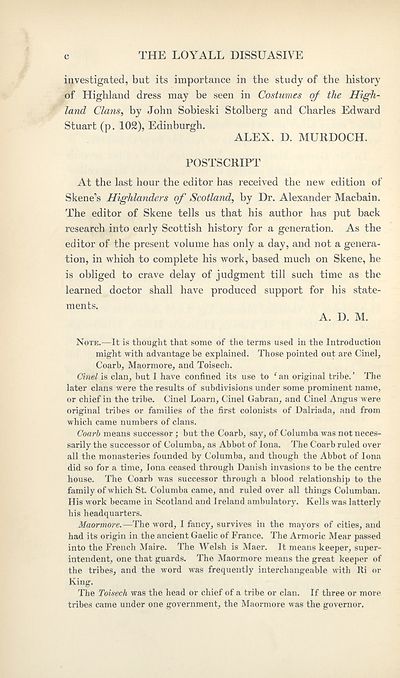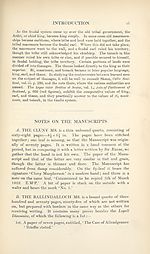Series 1 > Loyall dissuasive
(115) Page c - Postscript
Download files
Complete book:
Individual page:
Thumbnail gallery: Grid view | List view

THE LOYALL DISSUASIVE
investigated, but its importance in the study of the history
of Highland dress may be seen in Costumes of the High¬
land Clans, by John Sobieski Stolberg and Charles Edward
Stuart (p. 102), Edinburgh.
ALEX. D. MURDOCH.
POSTSCRIPT
At the last hour the editor has received the new edition of
Skene’s Highlanders of Scotland, by Dr. Alexander Macbain.
The editor of Skene tells us that his author has put back
research into early Scottish history for a generation. As the
editor of the present volume has only a day, and not a genera¬
tion, in which to complete his work, based much on Skene, he
is obliged to crave delay of judgment till such time as the
learned doctor shall have produced support for his state¬
ments.
A. D. M.
Note.—It is thought that some of the terms used in the Introduction
might with advantage be explained. Those pointed out are Cinel,
Coarb, Maormore, and Toisech.
Cinel is clan, but I have confined its use to ‘an original tribe.’ The
later clans were the results of subdivisions under some prominent name,
or chief in the tribe. Cinel Loarn, Cinel Gabran, and Cinel Angus were
original tribes or families of the first colonists of Dalriada, and from
which came numbers of clans.
Coarb means successor ; but the Coarb, say, of Columba was not neces¬
sarily the successor of Columba, as Abbot of Iona. The Coarb ruled over
all the monasteries founded by Columha, and though the Abbot of Iona
did so for a time, Iona ceased through Danish invasions to be the centre
house. The Coarb was successor through a blood relationship to the
family of which St. Columba came, and ruled over all things Columban.
His work became in Scotland and Ireland ambulatory. Kells was latterly
his headquarters.
Maormore.—The word, I fancy, survives in the mayors of cities, and
had its origin in the ancient Gaelic of France. The Armoric Mear passed
into the French Maire. The Welsh is Maer. It means keeper, super¬
intendent, one that guards. The Maormore means the great keeper of
the tribes, and the word was frequently interchangeable with Hi or
King.
The Toisech was the head or chief of a tribe or clan. If three or more
tribes came under one government, the Maormore was the governor.
investigated, but its importance in the study of the history
of Highland dress may be seen in Costumes of the High¬
land Clans, by John Sobieski Stolberg and Charles Edward
Stuart (p. 102), Edinburgh.
ALEX. D. MURDOCH.
POSTSCRIPT
At the last hour the editor has received the new edition of
Skene’s Highlanders of Scotland, by Dr. Alexander Macbain.
The editor of Skene tells us that his author has put back
research into early Scottish history for a generation. As the
editor of the present volume has only a day, and not a genera¬
tion, in which to complete his work, based much on Skene, he
is obliged to crave delay of judgment till such time as the
learned doctor shall have produced support for his state¬
ments.
A. D. M.
Note.—It is thought that some of the terms used in the Introduction
might with advantage be explained. Those pointed out are Cinel,
Coarb, Maormore, and Toisech.
Cinel is clan, but I have confined its use to ‘an original tribe.’ The
later clans were the results of subdivisions under some prominent name,
or chief in the tribe. Cinel Loarn, Cinel Gabran, and Cinel Angus were
original tribes or families of the first colonists of Dalriada, and from
which came numbers of clans.
Coarb means successor ; but the Coarb, say, of Columba was not neces¬
sarily the successor of Columba, as Abbot of Iona. The Coarb ruled over
all the monasteries founded by Columha, and though the Abbot of Iona
did so for a time, Iona ceased through Danish invasions to be the centre
house. The Coarb was successor through a blood relationship to the
family of which St. Columba came, and ruled over all things Columban.
His work became in Scotland and Ireland ambulatory. Kells was latterly
his headquarters.
Maormore.—The word, I fancy, survives in the mayors of cities, and
had its origin in the ancient Gaelic of France. The Armoric Mear passed
into the French Maire. The Welsh is Maer. It means keeper, super¬
intendent, one that guards. The Maormore means the great keeper of
the tribes, and the word was frequently interchangeable with Hi or
King.
The Toisech was the head or chief of a tribe or clan. If three or more
tribes came under one government, the Maormore was the governor.
Set display mode to:
![]() Universal Viewer |
Universal Viewer | ![]() Mirador |
Large image | Transcription
Mirador |
Large image | Transcription
Images and transcriptions on this page, including medium image downloads, may be used under the Creative Commons Attribution 4.0 International Licence unless otherwise stated. ![]()
| Scottish History Society volumes > Series 1 > Loyall dissuasive > (115) Page c - Postscript |
|---|
| Permanent URL | https://digital.nls.uk/127548385 |
|---|
| Attribution and copyright: |
|
|---|
| Description | Over 180 volumes, published by the Scottish History Society, containing original sources on Scotland's history and people. With a wide range of subjects, the books collectively cover all periods from the 12th to 20th centuries, and reflect changing trends in Scottish history. Sources are accompanied by scholarly interpretation, references and bibliographies. Volumes are usually published annually, and more digitised volumes will be added as they become available. |
|---|


